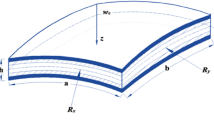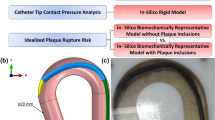Abstract
This study presents a three-dimensional finite element model of the mitral apparatus using a hyperelastic transversely isotropic material model for the leaflets. The objectives of this study are to illustrate the effects of the annulus shape on the chordal force distribution and on the mitral valve response during systole, to investigate the role of the anterior secondary (strut) chordae and to study the influence of thickness of the leaflets on the leaflets stresses. Hence, analyses are conducted with a moving and fixed saddle shaped annulus and with and without anterior secondary chordae. We found that the tension in the secondary chordae represents 31% of the load carried by the papillary muscles. When removing the anterior secondary chordae, the tension in the primary anterior chordae is almost doubled, the displacement of the anterior leaflet toward the left atrium is also increased. The moving annulus configuration with an increasing annulus saddle height does not give significant changes in the chordal force distribution and in the leaflet stress compared to the fixed annulus. The results also show that the maximum principle stresses in the anterior leaflet are carried by the collagen fibers. The stresses calculated in the leaflets are very sensitive to the thickness employed.
Similar content being viewed by others
References
Barlow JB (1987) Perspectives on the mitral valve. F.A. Davis, Philadelphia
Cochran RP, Kunzelman KS, Chuong CJ, Sacks MS, Eberhart RC (1991) Nondestructive analysis of mitral valve collagen fiber orientation. ASIAO Trans 37(3): 447–448
Dal Pan F, Donzella G, Fucci C, Schreiber M (2005) Structural effects of an innovative surgical technique to repair heart valve defects. J Biomech 38: 2460–2471
Einstein DR, Kunzelman KS, Reinhal P, Nicosia M, Cochran RP (2004) Haemodynamic determinants of the mitral valve closure sound: a finite element study. Med Biol Eng Comput 42: 832–846
Flachskampf FA, Chandra S, Gaddipatti A, Levine RA, Weyman AE, Ameling W, Hanrath P, Thomas JD (2000) Analysis of shape and motion of the mitral annulus in subjects with and without cardiomyopathy by echocardiographic 3-dimensional reconstruction. J Am Soc Echocardiogr 13(4): 277–87
Green GR, Dagum P, Glasson JR, Daughters GT, Bolger AF, Foppiano LE, Berry GJ, Ingels NB Jr, Miller DC (1999) Mitral annular dilatation and papillary muscle dislocation without mitral regurgitation in sheep. Circulation 100: 95–102
Ho SY (2002) Anatomy of the mitral valve. Heart 88: 5–10
Holzapfel GA, Sommer G, Gasser CT, Regitnig P (2005) Determination of the layer-specific mechanical properties of human coronary arteries with non-atherosclerotic intimal thickening, and related constitutive modelling. Am J Physiol Heart Circ Physiol 289: H2048–2058
Jimenez JH, Soerensen DD, He Z, He S, Yoganathan AP (2003) Effects of a Saddle Shaped Annulus on Mitral Valve Function and Chordal Force Distribution: An In Vitro Study. Annals of Biomedical Engineering 31: 1171–1181
Kaplan SR, Bashein G, Sheehan FH, Legget ME, Munt B, Li X-N, Sivarajan M, Bolson EL, Zeppa M, Martin RW (2000) Three-dimensional echocardiographic assessment of annular shape changes in the normal and regurgitant mitral valve. American Heart Journal 139: 378–87
Kunzelman KS, Cochran RP (1990) Mechanical properties of basal and marginal mitral valve chordae tendineae. ASAIO Trans 36: M405–408
Kunzelman KS, Cochran RP, Chuong C, Ring WS, Verrier ED, Eberhart RD (1993) Finite element analysis of the mitral valve. J Heart Valve Dis 2: 326–340
Lam JH, Ranganathan N, Wigle ED, Silver MD (1970) Morphology of the human mitral valve: I. Chordae tendinae: a new classification Circ 41: 449–458
Liao J, Vesely I (2003) A structural basis for the size-related mechanical properties of mitral valve chordae tendineae. J Biomech 36(8): 1125–33
Lim KH, Yeo JH, Duran CM (2005) Three-dimensional asymmetrical modeling of the mitral valve: a finite element study with dynamic boundaries. J Heart Valve Dis 14: 386–392
May-Newman K, Yin FCP (1995) Biaxial mechanical behavior of excised porcine mitral valve. J Biomech Eng 120: 38–47
May-Newman K, Yin FCP (1998) A constitutive law for mitral valve tissue. Am J Physiol 269: 1319–1327
Nielsen SL, Nygaard H, Fontaine AA, Hasenkam JM, He S, Andersen NT, Yoganathan AP (1999) Chordal force distribution determines systolic mitral leaflet configuration and severity of functional mitral regurgitation - design of a new surgical approach for ventricular remodeling to relieve ischemic mitral regurgitation. Journal of the American College of Cardiology 33: 843–853
Prot V, Skallerud B, Holzapfel GA (2007a) Effects of connective tissue pathologies on mitral valve response. MHM 2007, Modelling of heterogeneous materials with applications in construction and biomedical engineering, Prague 106–107
Prot V, Skallerud B, Holzapfel GA (2007b) Transversely isotropic membrane shells with application to mitral valve mechanics. Constitutive modeling and finite element implementation. International Journal for Numerical Methods in Engineering 71(8): 987–1008
Prot V (2008) Numerical modelling of the mitral apparatus (PhD thesis). Trondheim, Norway. Norwegian University of Science and Technology
Ritchie J, Jimenez J, He Z, Sacks MS, Yoganathan AP (2006) The material properties of the native porcine mitral valve chordae tendineae: an in vitro investigation. J Biomech 39(6): 1129–35
Sacks MS, He Z, Baijens L, Wanant S, Shah P, Sugimoto H, Yoganathan AP (2002) Surface Strains in the Anterior Leaflet of the Functioning Mitral Valve. Annals of Biomedical Engineering 30: 1281–1290
Salgo IS, Gorman JH, Gorman RC, Jackson BM, Bowen FW, Plappert T, StJohn Sutton MG, Edmunds LH Jr (2002) Effect of annular shape on leaflet curvature in reducing mitral leaflet stress. Circulation 106(6): 711–7
Sanfilippo AJ, Harrigan P, Popovic AD, Weyman AE, Levine RA (1992) Papillary muscle traction in mitral valve prolapse: quantitation by two-dimensional echocardiography. J Am Coll Cardiol 19: 564–571
Sedrandsk L, Grande-Allen KJ, Vesely I (2002) Failure mechanics of mitral valve chordae tendinae. Journal of Heart Valve Disease 11: 644–650
Spencer AJM (1984) Constitutive theory for strongly anisotropic solids. In: Spencer AJM (ed) Continuum Theory of the Mechanics of Fibre-Reinforced Composites, pages 1–32. Springer-Verlag, Wien. CISM Courses and Lectures No. 282, International Centre for Mechanical Sciences
Tibayan FA, Rodriguez F, Zasio MK, Bailey L, Liang D, Daughters GT, Langer F, Ingels NB Jr, Miller DC (2003) Geometric Distortions of the Mitral Valvular-Ventricular Complex in Chronic Ischemic Mitral Regurgitation. Circulation 108: 116–121
Votta E, Maisano F, Soncini M, Redaelli A, Montevecchi FM, Alfieri O (2002) 3-D computational analysis of the stress distribution on the leaflets after edge-to-edge repair of mitral regurgitation. J Heart Valve Dis 11: 810–822
Author information
Authors and Affiliations
Corresponding author
Rights and permissions
About this article
Cite this article
Prot, V., Haaverstad, R. & Skallerud, B. Finite element analysis of the mitral apparatus: annulus shape effect and chordal force distribution. Biomech Model Mechanobiol 8, 43–55 (2009). https://doi.org/10.1007/s10237-007-0116-8
Received:
Accepted:
Published:
Issue Date:
DOI: https://doi.org/10.1007/s10237-007-0116-8




